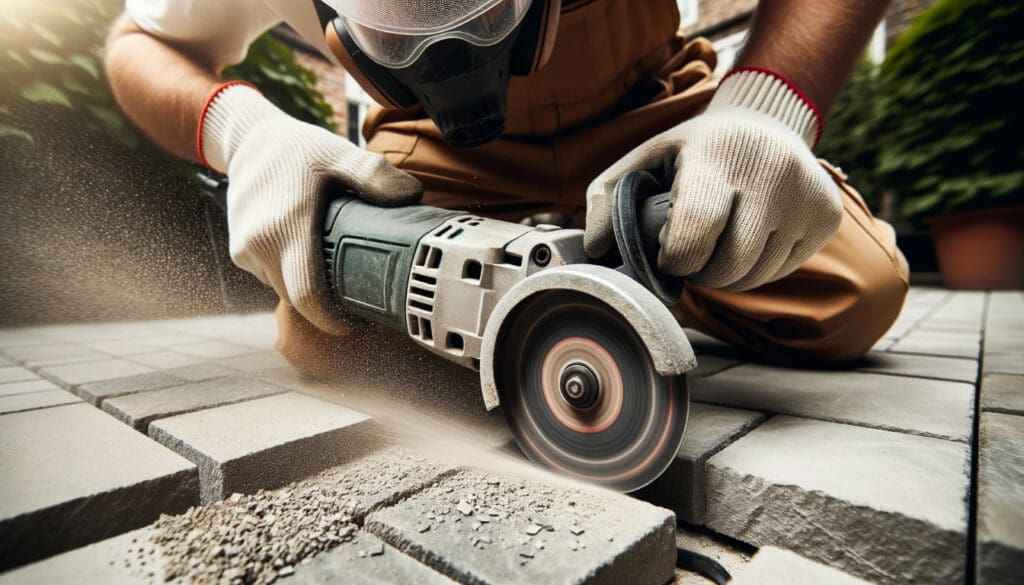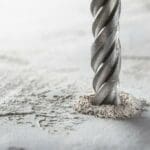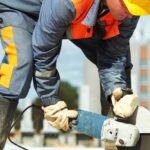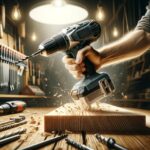An angle grinder is a versatile power tool used for various tasks, from cutting and grinding to polishing and sharpening. Its ability to handle different materials, such as metal, wood, and even stone, makes it a valuable tool in any workshop or DIY project. However, it is crucial to use an angle grinder with caution and the correct safety measures due to its power and speed.
In this article, we will provide a comprehensive guide on using an angle grinder safely and effectively. We will cover the essential tools and safety equipment you need, the different types of angle grinders available, and the various applications of this versatile tool. Furthermore, we will address the importance of using the correct discs for specific tasks, as using the wrong discs can lead to accidents and damage to the grinder.
Whether you are a seasoned professional or a beginner, understanding an angle grinder’s proper usage and safety procedures is vital. By following the guidelines outlined in this article, you can make the most of this powerful tool while minimizing the risk of accidents. So, let’s dive in and explore the world of angle grinders!
What can you use an angle grinder for?
An angle grinder is a powerful and versatile tool that can be used for various tasks. Its primary function is cutting and grinding, making it ideal for cutting metal pipes, steel bars, or tiles. It can also be used for polishing and sharpening, allowing you to achieve a smooth and polished finish on metal or wood surfaces. Additionally, an angle grinder can be used for removing rust or paint from metal surfaces and shaping and sculpting materials. Its ability to handle different materials and tasks makes it an invaluable tool for professionals and DIY enthusiasts. However, it is essential to remember always to use the appropriate discs and safety equipment when operating an angle grinder, as safety should always be a top priority.
Cutting and polishing metal
An angle grinder is a multifaceted power tool predominantly used for cutting and polishing metal. Its versatility has become an essential instrument in many workshops and construction sites.
Safety Precautions:
Safety should be the top priority before diving into any task with the angle grinder. Users must equip themselves with essential protective gear. This includes safety glasses to protect the eyes from flying debris, ear protection to guard against the loud noise produced by the grinder, and safety boots to shield the feet from falling objects or sparks.
Selecting the Right Disc:
The outcome of the task largely depends on the choice of disc. Two primary discs are employed for metalwork: the grinding disc and the polishing wheel. These discs are available in different thicknesses, tailored for specific jobs. It’s crucial to pick the one that aligns with the task to ensure efficiency and safety.
Attaching the Disc:
Before the attachment process, it’s imperative to ensure the angle grinder is unplugged to avoid any accidental startups. Once safe, the disc can be mounted onto the grinder’s spindle. Proper alignment and a secure fit prevent wobbles or mishaps during operation.
Grinding and Polishing Techniques:
The angle grinder should be held with both hands for stability when grinding metal. The disc should contact the metal surface at an angle ranging between 5°-10°. Using light pressure, the grinder should be moved smoothly across the surface. This technique ensures an even finish and reduces the risk of gouging the metal.
Cutting Metal:
For cutting tasks, a switch to a cut-off disc is necessary. Unlike grinding, the angle grinder should be positioned at a 90-degree angle to the metal surface. Ensuring the metal piece is firmly clamped or held in place is essential. With firm pressure, the user should make a steady, controlled cut to achieve a clean break.
Disc Speed and Safety:
Every disc comes with a recommended speed limit set by the manufacturer. Adhering to this speed is critical as exceeding it can cause the disc to break, posing a potential safety hazard. Always consult the manufacturer’s guidelines to ensure safe and effective use.
In conclusion, when used with the right techniques and safety precautions, angle grinders prove invaluable for metalwork. Their ability to deliver clean cuts and polished finishes makes them indispensable for professionals and hobbyists.
Cutting and polishing wood
An angle grinder for woodwork tasks like cutting and polishing can expedite the process, allowing for efficient shaping and carving of wooden materials. Here’s a comprehensive overview of the steps and precautions to take:
Safety Measures:
Safety is paramount when working with power tools. Before beginning any woodwork with an angle grinder, ensure you’re equipped with essential protective gear. This includes safety glasses for eye protection, ear protection to guard against the loud noise of the machine, and safety boots to shield your feet. Additionally, it’s crucial to operate in a well-ventilated space. This will help prevent the accumulation of wood dust, which can be harmful when inhaled.
Selecting the Right Blade:
The choice of blade is pivotal to achieving the desired results in woodwork. Two main types of blades are typically used: abrasive flap blades and abrasive carving blades. The former is perfect for sanding and smoothing out wooden surfaces. In contrast, the carving blades are crafted specifically for detailed shaping and carving tasks, allowing for precision and intricate designs.
Blade Attachment Process:
Safety comes first, so always ensure the angle grinder is unplugged before making any modifications or attachments. Once sure, you can mount the chosen blade onto the grinder’s spindle. Proper alignment ensures smooth operation, so ensure the blade is centred. Once aligned, tighten the spindle’s nut to secure the blade firmly.
Wood Cutting Techniques:
The angle grinder should be oriented for cutting tasks such that the cutting disc forms a 90-degree angle with the wood’s surface. Before cutting, ensure the wooden material is clamped or securely placed. This prevents any unintended movements. Then, with firm and steady pressure, move the grinder in a controlled motion to achieve a clean cut.
Wood Polishing Techniques:
When polishing, an abrasive flap blade becomes the tool of choice. Holding the angle grinder securely with both hands, position the flap blade at a slight angle relative to the wooden surface. With gentle pressure, glide the grinder in a consistent, fluid motion across the surface. This will effectively sand and polish the wood, giving it a refined finish.
In conclusion, while angle grinders are incredibly efficient for woodwork, it’s vital to approach tasks with caution and patience. Adhering to safety guidelines and using the right techniques will ensure a job well done and a safe woodworking experience.
Cutting concrete, pavers and stone

Cutting concrete, pavers, and stone with an angle grinder requires specific techniques and tools to ensure a clean and precise cut. Here are the steps to follow:
1. Safety First: Always wear safety glasses, protective gear, and a dust mask when cutting hard materials. This will protect you from debris and minimize the inhalation of dust particles.
2. Choose the Right Blade: For cutting concrete, pavers, and stone, use a segmented rim diamond cutting disc. These discs are designed to reduce dust and cool the blade during cutting. They are compatible with bricks, masonry, pavers, granite, and limestone materials.
3. Prepare the Material: Before cutting, wet the material with water to minimize the generation of grime and dust. This will also help cool the blade and prolong its lifespan.
4. Secure the Material: Ensure the concrete, pavers, or stone is securely clamped or fixed before cutting. This will prevent movement or shifting, resulting in an uneven or inaccurate cut.
5. Start Cutting: Position the angle grinder with the segmented rim disc at a 5°-10° angle to the material. Apply light pressure and start cutting slowly, following the desired cutting line. Make sure to maintain a steady and controlled motion throughout the cutting process.
6. Regularly Replace the Blade: Inspect the segmented rim disc for wear and tear to achieve a clean and precise cut. Replace the disc if you notice any chipping, cracking, or excessive wear to ensure optimal cutting performance.
Always prioritize safety and follow the manufacturer’s instructions when using an angle grinder to cut concrete, pavers, and stone.
Light Work or Sanding
When it comes to light work or sanding with an angle grinder, it’s essential to hold the tool at the correct angle and apply the right amount of pressure. For sanding applications, it is recommended to hold the angle grinder at a 5°-10° angle to the work surface. This angle allows for effective material removal while maintaining control and precision.
However, it’s crucial to remember that you should apply minimum pressure when sanding. Let the tool and abrasive accessory do the work. Applying too much pressure can result in uneven or excessive material removal and may even damage your working surface.
You can achieve smooth and even results by holding the angle grinder at the correct angle and applying light pressure. Remember to use the appropriate abrasive disc or wheel for sanding applications. Specific discs are available for each job, whether you are working on wood, metal, or other materials.
Always wear safety gear, such as safety glasses and a dust mask, to protect yourself from debris. Additionally, follow all safety precautions and guidelines provided by the manufacturer.
Angle grinders are versatile power tools that can handle various tasks. By understanding the correct angle to hold the tool and the pressure to apply, you can achieve professional-looking results in your light work or sanding applications.
Precautions
Precautions are important to ensure your safety when using an angle grinder. Always wear protective gear, such as safety glasses, to shield your eyes from debris and a dust mask to prevent inhaling harmful particles. Familiarize yourself with the safety procedures and guidelines provided by the manufacturer before operating the tool. Using the correct abrasive disc or wheel for your application is also crucial. Applying too much pressure can damage the surface and result in uneven material removal, so it is essential to maintain a firm but light grip on the tool. Lastly, be cautious of flammable materials and ensure that you work in a well-ventilated area to minimize potential hazards. Following these precautions, you can safely and effectively use an angle grinder for various tasks.
Gathering Necessary Supplies and Protective Equipment
Before starting any task with an angle grinder, gathering the necessary supplies and protective equipment is vital. By doing so, you can ensure a safe and efficient work environment. Here are some essential items to have on hand:
1. Safety Glasses: Protecting your eyes is crucial when using power tools like an angle grinder. Safety glasses with impact-resistant lenses can shield against flying debris and sparks.
2. Earplugs: Angle grinders can generate high levels of noise, which can cause hearing damage over time. Wearing earplugs or earmuffs can help safeguard your hearing.
3. Face Shield: A face shield provides additional protection for your face and neck. It guards against flying particles and sparks, offering an extra layer of safety.
4. Leather Apron: Working with an angle grinder may produce sparks or debris that can land on your clothes. Wearing a leather apron can help protect you from burns and keep your clothes clean.
5. Sturdy Gloves: Choose gloves that fit tightly and are made from durable material like leather. They offer protection against cuts, scratches, and burns, ensuring your hands are safeguarded during use.
Gathering these supplies and wearing proper protective equipment can minimize the risk of injury and create a safe working environment when using an angle grinder. Prioritize your safety to ensure a successful and accident-free project.
Guard Yourself Against Kickback
When using an angle grinder, it is crucial to guard against the potential dangers of kickback. Kickback occurs when the grinder’s rotating wheel suddenly jerks or bounces back towards the operator. This can result in serious injuries if proper precautions are not taken.
Always ensure the grinder is equipped with appropriate blade guards to prevent kickback. Blade guards act as protective barriers, deflecting debris and providing a physical barrier between the operator and the spinning wheel. They are designed to reduce the risk of kickback, making them an essential safety feature.
Another important measure to guard against kickbacks is using support materials. When cutting through materials like wood or metal, it is recommended to provide solid support to prevent sagging or movement that can cause the rotating wheel to bind or kick back.
Kickback can also occur during grinding tasks, especially when encountering corners or sharp edges. Maintaining a light pressure and avoiding excessive force while operating the grinder is important. Using an auxiliary handle can also provide additional leverage and control, reducing the risk of kickback.
Remember always to use both hands when operating the angle grinder. This ensures better control and stability, minimizing the chances of kickback. By following these safety precautions and using the appropriate tools and equipment, you can significantly reduce the risk of kickback and work with your angle grinder safely and effectively.
Adjusting your speed and matching accessories
When using an angle grinder, adjusting the tool’s speed to match the accessory being used is important. Different tasks require different speeds to ensure optimal performance and safety.
Matching the appropriate speed can prevent accidents and damage to both the tool and the accessory. Exceeding the accessory’s maximum RPM (revolutions per minute) can cause it to break apart, posing potential hazards to the operator. Always check the recommended speed range for your specific accessory and adjust your angle grinder accordingly.
To ensure safe and efficient operation, it is crucial to consider the safety features of an angle grinder. Look for a wheel brake system which allows the grinder to come to a quick stop after use, reducing the risk of accidents. Noise reduction features can help minimize the disruptive noise generated by the tool, making it more comfortable to use. Vibration reduction is also important, as excessive vibration can lead to fatigue and long-term health issues.
By adjusting the speed of your angle grinder and matching the accessories properly, you can ensure safe and effective operation. Take the time to understand the recommended RPM for each accessory and invest in a grinder with the necessary safety features, such as a wheel brake system, to make your work environment safer and more efficient.



